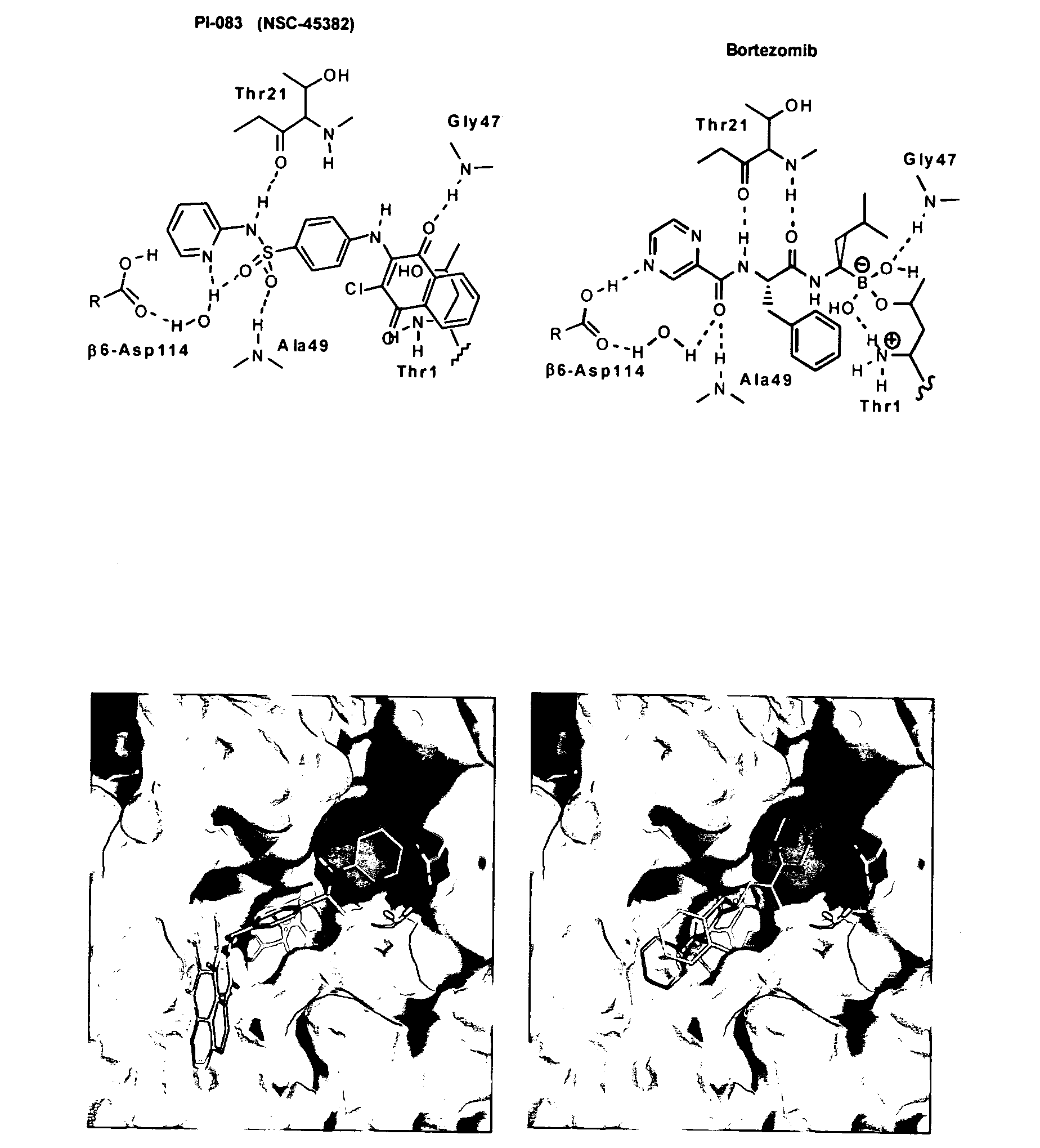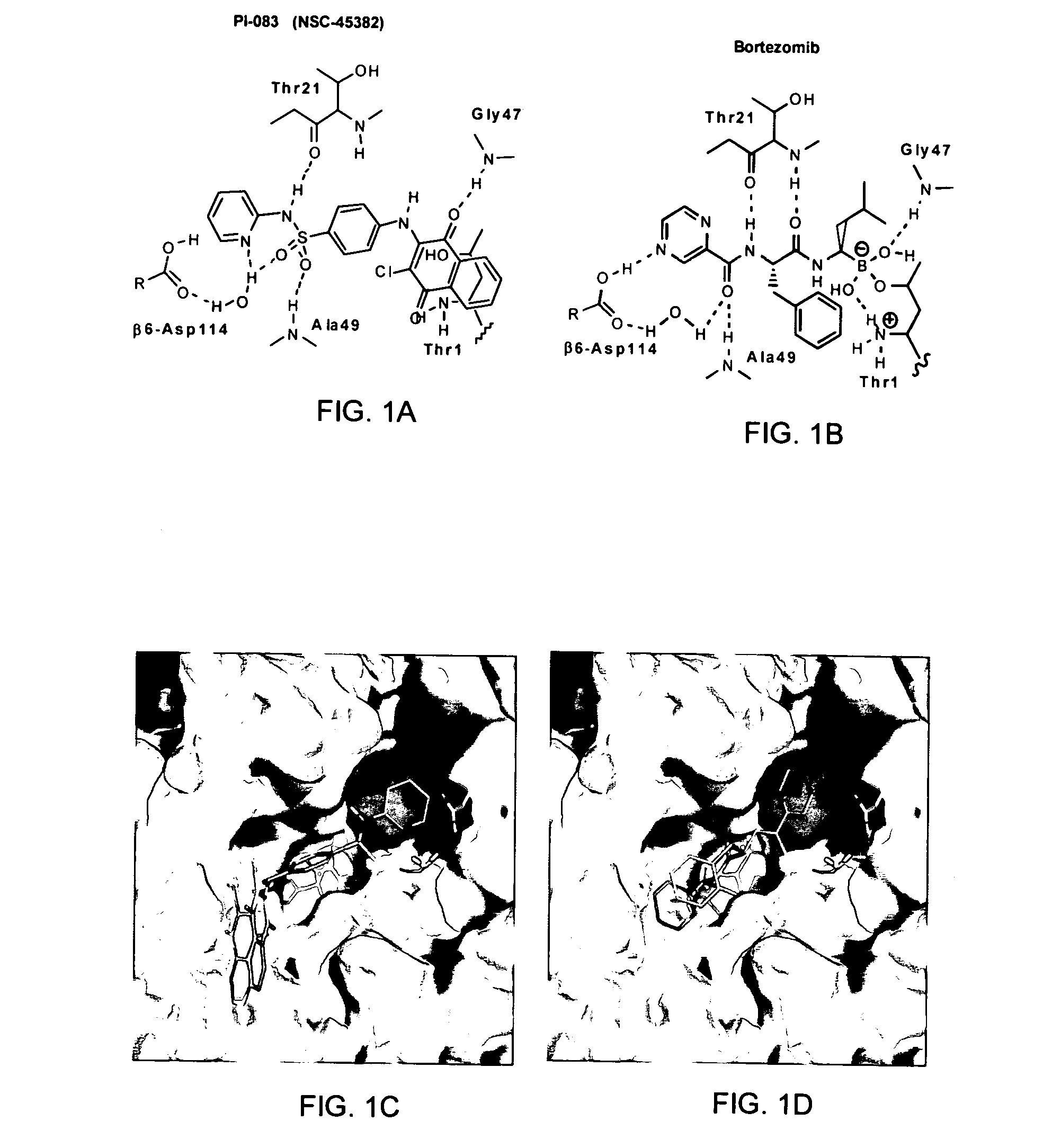Proteasome inhibitors for selectively inducing apoptosis in cancer cells
a technology of apoptosis and proteasome inhibitors, which is applied in the direction of drug compositions, chemical treatment enzyme inactivation, amide active ingredients, etc., can solve the problem that velcade has only marginal effects
- Summary
- Abstract
- Description
- Claims
- Application Information
AI Technical Summary
Benefits of technology
Problems solved by technology
Method used
Image
Examples
example 1
Proteasome Inhibitors Exhibit Broad Antitumor Activity and Limited Toxicity
[0114]The only FDA-approved proteasome inhibitor bortezomib exhibits both toxicity and a limited anti-tumor activity spectrum. Accordingly, proteasome inhibitors with a broader antitumor activity spectrum and less toxicity are required. To this end, both experimental and virtual HTS was used to screen chemical libraries from the NCI. For the experimental portion, the NCI Diversity Set (1,990 compounds), the Natural Product Set (235 compounds), and the Challenge and Mechanistic Sets (1,004 compounds) were screened against the CT-L activity of the proteasome. Eight compounds with IC50 values50=1 μM), was confirmed with in-house synthesized material and is shown along with the structure of bortezomib in FIGS. 1A and B.
[0115]In order to determine the utility of virtual screening to potentially identify additional lead compounds from other NCI libraries like the Plated Set or from commercial sources, virtual scree...
example 2
PI-083 Inhibits CT-L and Cell Proliferation Selectively in Cancer Cells Over Their Non-Transformed Counterparts
[0119]Taken together, FIGS. 1A-1D and the IC50 values indicated above indicate that although PI-083 and bortezomib appear to bind similarly to the CT-L activity of the proteasome, their potency and selectivity towards the 3 proteolytic activities of the proteasome are different. The ability of these two proteasome inhibitors to inhibit growth and induce apoptosis in tumor compared to non-transformed cells was determined. To this end, 3 pairs of cell lines from breast, ovarian and pancreatic origin were used. The first pair consists of MCF-7 (a human breast cancer cell line) and MCF-10A (an immortalized non-transformed breast cell line). The second consists of T-80 normal human ovarian cells immortalized with Large T-antigen (inactivates both p53 and pRb) and hTERT (human telomerase) based on the original Weinberg model (Hahn and Weinberg, 2002; Rangarajan et al., 2004) and ...
example 3
PI-083 Selectively Induces Apoptosis in Cancer Cells Over Non-Transformed Cells
[0123]FIGS. 3A-3F and Table 3 show major differences between PI-083 and bortezomib, with PI-083, but not bortezomib, being more selective towards inhibiting the proliferation of cancer over non-transformed cells. The ability of PI-083 and bortezomib to induce cell death (Trypan Blue) and apoptosis (TUNEL) in the above 3 pairs of cancer / non-transformed cell lines was determined as described under Materials and Methods. As seen with proliferation assays, PI-083 was much more effective in increasing cell death in all 3 cancer cell lines over their non-transformed counterparts, whereas bortezomib was not (FIGS. 4A-4F). These results were confirmed by TUNEL assay: FIGS. 5A-5C show that P1-083 induced apoptosis in all 3 cancer cell lines MCF-7, T-80-Hras and C7-Kras, with MCF-7 being the most sensitive. In contrast, PI-083 did not induce apoptosis in non-transformed MCF-10A and C7 and induced very little apopto...
PUM
| Property | Measurement | Unit |
|---|---|---|
| pKa | aaaaa | aaaaa |
| pH | aaaaa | aaaaa |
| pH | aaaaa | aaaaa |
Abstract
Description
Claims
Application Information
 Login to View More
Login to View More - R&D
- Intellectual Property
- Life Sciences
- Materials
- Tech Scout
- Unparalleled Data Quality
- Higher Quality Content
- 60% Fewer Hallucinations
Browse by: Latest US Patents, China's latest patents, Technical Efficacy Thesaurus, Application Domain, Technology Topic, Popular Technical Reports.
© 2025 PatSnap. All rights reserved.Legal|Privacy policy|Modern Slavery Act Transparency Statement|Sitemap|About US| Contact US: help@patsnap.com



